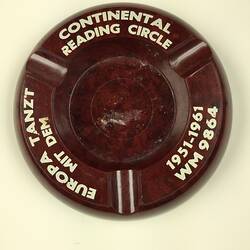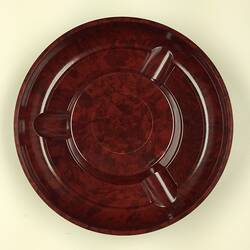Summary
Bakelite ashtray inscribed with 'Continental Reading Circle 1951-1961' and text in German language. It is a souvenir relating to an organisation that provided a subscription lending library to post World War II migrants of German language magazines.
Ed Lagzdin migrated as a child with his parents and two siblings from Italy via Germany in 1949. The family was Latvian and unwilling to return to Soviet Latvia. They sailed on the Fairsea in October 1949 and arrived at Station Pier, Melbourne where they were taken to Bonegilla Migrant Reception Centre for about one month. The family then moved into a large, two storey, converted boarding house 'Haven' at 201 Williams Road, South Yarra, where they lived for about two years with other German, Russian and Latvian migrants. The donor recalls a man with a large portfolio with leather corners, tied together neatly by a shoe lace, visiting the house every week, dropping off and picking up magazines. The magazines were circulated around the house.
Physical Description
Mottled burgundy-coloured bakelite ashtray with white script on the top.
Significance
Statement of Historical Significance:
This item provides an interesting example of services provided to post WWII migrants in languages other than English. Language is a key migration theme in terms of cultural identity as well as settlement and integration experiences.
This bakelite ashtray, inscribed with 'Continental Reading Circle 1951-1961' and text in German language, is a souvenir relating to an organisation that provided a subscription lending library to post World War II migrants of German language magazines. The collection currently holds no material relating to this organisation and provides an interesting example of services provided to post WWII migrants in languages other than English. Language is a key migration theme in terms of cultural identity as well as settlement and integration experiences. This story compliments the English-language courses in the collection, German language shipboard newsletters, and the 19th century mulit-lingual newsletter.
More Information
-
Collecting Areas
-
Inscriptions
'EUROPA TANZ'T/MIT DEM/CONTINENTAL/READING CIRCLE/1951-1961/WM 9864'
-
Classification
-
Category
-
Discipline
-
Type of item
-
Keywords



